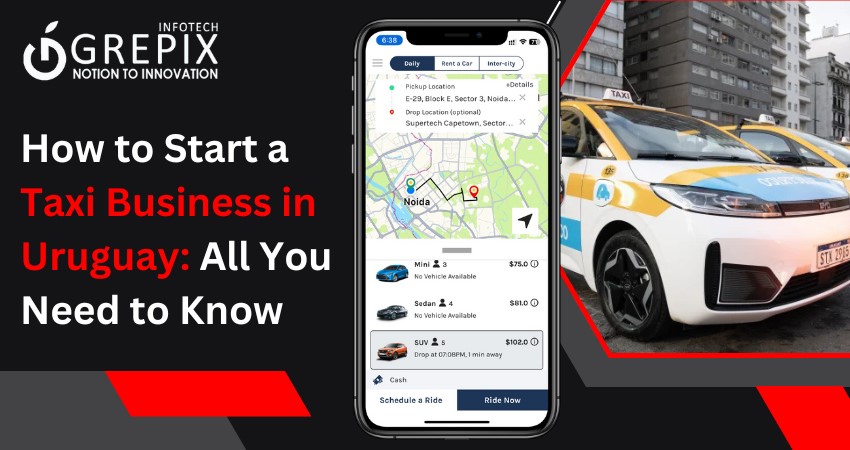How to Start a Taxi Business in Uruguay: All You Need to Know
Uruguay, a South American gem known for its stable economy, high standard of living, and flourishing tourism sector, presents a fertile ground for launching a taxi business. With rising urban mobility needs, digital transformation, and a growing demand for reliable transportation services, now is the perfect time to invest in the taxi industry in Uruguay. Whether you’re targeting the bustling streets of Montevideo or the scenic coastal towns like Punta del Este, a well-planned taxi business can prove to be highly profitable. In this guide, we provide a comprehensive, step-by-step roadmap for starting a taxi business in Uruguay from market research to fleet management and technology integration.
Launching a taxi business in Uruguay presents a high-potential opportunity for entrepreneurs with a vision for mobility innovation. From securing business registration and taxi licenses to setting up your fleet, tech integration is the key differentiator in today's transport sector. With increasing smartphone usage and a rising demand for safe, cashless ride options, app-based services are becoming essential. Grepix Infotech offers a fast, cost-effective way to build and deploy a customized, white-label taxi app suited for the Uruguayan market. Key steps include legal compliance, market research, technology implementation, driver hiring, and customer-focused service. Marketing strategies like referrals and partnerships enhance visibility, while expansion into new cities and services ensures long-term growth. Whether you're starting in Montevideo or scaling to tourist hubs like Punta del Este, this guide gives you a complete roadmap to launch, grow, and dominate the local taxi industry with the right tools and knowledge..
1Overview of the Current Transportation Landscape
Uruguay, a small but progressive country in South America, boasts a strong infrastructure and a highly urbanized population. With major cities like Montevideo, Punta del Este, and Salto witnessing increasing urban mobility needs, public transportation has become both an opportunity and a challenge. Traditional taxis have long served as a backbone of urban transport, but now the industry is poised for a digital revolution
Unlike some neighboring nations, Uruguay is known for its strict regulations but cooperative approach toward tech-driven solutions. This makes it an ideal environment for launching a legitimate, app-based taxi business that complies with local laws while satisfying modern consumer expectations.
The existing taxi market in Uruguay is ripe for transformation. Riders want faster service, accurate fare calculation, better vehicle standards, and digital payment options. If you've been thinking about starting a transportation business, now is the perfect time to capitalize on this gap with a modern taxi fleet and an efficient ride-booking app.
2Growing Demand for App-Based Taxi Services
In the age of convenience, Uruguayans are increasingly turning to their smartphones for everything from groceries to transport. Ride-hailing apps like Uber and DiDi have already entered the market, but they often face regulatory hurdles and lack the local flavor that homegrown solutions can provide. This opens a massive opportunity for entrepreneurs who understand the culture and can offer locally-branded, tech-enabled taxi services.
App-based taxi services are especially in demand among:
- Young professionals who value speed and tech-savviness.
- Tourists looking for reliable, English-friendly rides.
- Residents in cities with limited or unreliable public transport.
With high smartphone penetration and growing digital literacy, Uruguay offers a fertile ground for launching an app-based taxi company. The key to winning this market? Offering a service that is fast, fair, transparent, and compliant with local laws—something that traditional taxis struggle with, and international ride-sharing apps haven't fully achieved.
3Market Research & Planning
1. Target Cities and Regional Opportunities
The success of any taxi business starts with choosing the right location. In Uruguay, your best bets are:
- Montevideo – The capital and most populated city. Great for launching, but also highly competitive.
- Punta del Este – A popular tourist destination with seasonal peaks in demand.
- Salto, Paysandú, Rivera – Emerging urban hubs with less competition and growing populations.
Conduct localized research for each target city. Look at:
- Population density
- Availability of public transport
- Tourist influx
- Road infrastructure
- Presence of universities, offices, and hospitals
These factors influence the volume and frequency of rides, and can help you decide whether to begin with a single-city focus or aim for a multi-city rollout.
2. Competitor Analysis & Identifying Gaps
Before diving in, you need to understand who your competitors are and what they're doing wrong. Ask yourself:
- What are users complaining about in current services?
- Are wait times too long?
- Are fares unpredictable?
- Are drivers untrained or vehicles outdated?
Go through Google Reviews, app ratings, and even take a few test rides to experience it for yourself. Many existing services lack:
- Real-time tracking
- In-app payments
- Bilingual support (Spanish-English)
- Reliable customer service
If you can solve these pain points, you're not just entering the market—you're redefining it.
3. Cost Projections and Revenue Modeling
A clear financial model will guide your decision-making and help you secure funding if needed. Your primary startup costs will include:
- Business registration and licensing
- Vehicle purchase or lease
- App development (or white-label solution)
- Insurance
- Marketing
- Driver training and onboarding
A rough estimate to launch a small fleet (5–10 cars) with a basic app platform can range between $25,000 to $50,000 USD in Uruguay, depending on customization and operational scale. Revenue will depend on:
- Fare per ride
- Daily ride volume
- Driver commission model>
- Optional services (parcel delivery, corporate accounts)
Using Grepix's ready-made platform, many startups break even in under 6 months due to lower tech investment and faster go-to-market.
4Choosing a Business Model
1. Owner-Operator vs. Aggregator
There are two primary ways to operate a taxi business:
- Owner-Operator Model: You own the vehicles and hire drivers.
- Aggregator Model: Independent drivers use your app and brand to operate.
Owner-Operator Pros:
- Full control over fleet and quality>
- Easier to maintain brand consistency
- Suitable for premium or executive service
Aggregator Pros:
- Lower capital investment
- Faster to scale
- Easier driver onboarding
Many successful startups begin with a hybrid model—owning a few core vehicles while allowing independent drivers to join the network. Grepix software supports both with separate management dashboards.
2. Franchise, Partnership, or Independent Brand?
Here's how each option works in Uruguay:
- Franchise: Join an established brand and operate under their name.
- Partnership:Collaborate with local stakeholders (e.g., hotel chains, car dealerships).
- Independent:Build your own brand from scratch.
Going independent gives you full control, while partnerships help with market penetration and capital. Franchising might reduce marketing needs but often limits innovation.
3. Monetization Options: Commissions, Flat Fees, Subscriptions
Your revenue model can vary:
- Commission-Based: Take a % of each ride fare. (Most common)
- Flat Monthly Fees: Drivers pay to use the platform.
- Subscription Plans: Passengers pay a monthly fee for discounted rides.
Grepix allows you to integrate multiple monetization models into your app. Flexibility is key as you test what works best in Uruguay's varied markets.
5Legal Structure & Registration
1. Company Formation in Uruguay
Before you hit the road, you'll need to officially register your business. Steps include:
- Choose your legal entity (SRL, SA, or sole proprietorship)
- Register with the DGI (Dirección General Impositiva) for tax compliance
- Obtain a RUT (Unique Taxpayer Number)
- Register your brand name and domain
Depending on your business model, you may also need:
- Employer registration with BPS (Social Security Agency)
- Import permits if you're bringing in vehicles
Having a local legal advisor is highly recommended, especially if you're not a Uruguayan citizen.
2. Getting a Taxi License and Vehicle Registration
Taxi licenses are issued at the municipal level. Each city has its own procedures and vehicle requirements. For example, Montevideo's IMM (Intendencia Municipal de Montevideo) oversees taxi permits. Common requirements include:
- Vehicle must be less than 5 years old
- Yellow-and-black paint scheme
- Digital fare meter
- Security equipment (camera, panic button)
- Proof of insurance
- Emission certification
Vehicle registration is done through SUCIVE, the national system for vehicle control and taxation. Note: There is a cap on the number of taxi licenses in major cities. You may need to buy a license from an existing holder on the secondary market.
3. Compliance with Local and National Laws
Taxi operators must comply with:
- National transit laws
- Municipal transport policies
- Taxation and employment regulations
- Digital platform standards (for app-based services)
Failure to meet these can lead to fines, license cancellation, or app bans. The good news? Grepix's platform is fully adaptable to Uruguay's legal ecosystem, ensuring you're always in compliance.
6Insurance and Safety Regulations
1. Compulsory Insurance Requirements
In Uruguay, operating a taxi legally requires multiple layers of insurance to protect both the business owner and the passenger. The most basic policy is SOA (Seguro Obligatorio de Automotores), a mandatory vehicle insurance covering injuries to third parties in case of accidents.
But that's just the start. For a robust taxi business, you should consider:
- Comprehensive Vehicle Insurance – Covers damages, theft, fire, and vandalism.
- Passenger Liability Insurance – Protects against legal claims from injured riders.
- Driver Health and Accident Insurance – Especially if you employ drivers under contract.
Insurance costs vary based on the type, number, and age of vehicles. Make sure to choose insurers experienced with commercial taxi operations. Some insurers offer bulk deals or fleet coverage at a discount. Having the right insurance in place is not just a legal requirement—it's a competitive edge. Riders are more confident booking with operators who guarantee safety and responsibility.
2. Passenger Safety Regulations
Uruguayan transport authorities take passenger safety seriously. The Intendencias Municipales (municipal governments) mandate several features in licensed taxis:
- Panic Button – Must be easily accessible by drivers and linked to emergency services.
- GPS Tracking – For real-time monitoring and route history.
- Security Cameras – In some cities, especially Montevideo, front-facing and interior cams are mandatory.
- Fare Display System – Transparent pricing visible to passengers.
When building your fleet, make sure all safety protocols are installed and functioning. Grepix's taxi software integrates panic button alerts and real-time GPS tracking, offering an additional layer of digital safety for both drivers and passengers.
3. Accident Protocols and Legal Liabilities
If a passenger is injured during a ride, the driver and the company may both be liable, depending on the cause and contractual status.
Here's what to do:
- Call emergency services immediately
- Log the incident in your app system
- Provide passenger and driver with legal and insurance contact info
- Notify your insurer within 24 hours
You should also maintain digital logs via your app. Grepix's admin dashboard allows you to store trip data, driver logs, and GPS trails for legal evidence. This documentation is critical if any disputes or claims arise.
7Technology Integration
1. Importance of Taxi Booking Apps
Uruguayan consumers, particularly in urban areas, are shifting from street hailing to app-based services. If your taxi business lacks a modern digital platform, you're missing a huge share of the market. A robust app solution:
- Increases ride volume with 24/7 booking
- Reduces missed calls and manual errors
- Provides transparent fare calculations
- Offers convenience for both locals and tourists
Taxi apps aren't a luxury anymore—they're essential infrastructure. Even legacy taxi operators in Uruguay are adopting apps to stay competitive. This is where having a custom, white-label solution like Grepix becomes your strongest asset.
2. Must-Have Features for Driver and Rider Apps
An effective taxi app must deliver a seamless experience to both users and drivers. Grepix's solution includes:
- Live Ride Tracking – Real-time map updates.
- Multi-Payment Options – Cash, card, mobile wallets.
- Promo Codes & Referrals – For user acquisition.
- Multilingual Interface – Spanish and English to cater to locals and tourists.
- SOS Alerts – Integrated emergency buttons for in-ride safety.
- In-App Chat – Smooth communication between driver and rider.
The driver app must include:
- Trip history
- Earnings summary
- Ride alerts
- Route optimization
- Performance metrics
These features don't just improve operations—they build trust and brand loyalty.
3. Admin Dashboard and Dispatch Panel Overview
Behind the scenes, your admin panel is the heartbeat of your taxi business. Grepix offers a sleek, powerful dashboard that allows you to:
- View and manage all active bookings
- Track vehicle locations in real-time
- Onboard drivers and approve documents
- Generate financial and performance reports
- Manage refunds, complaints, and feedback
- Send push notifications and promo messages
If you're operating across multiple cities, you can manage everything from one unified interface adjusting pricing, availability, and language settings as needed. Grepix's panel also supports heat maps and demand prediction, helping you plan peak-time strategies and driver placements.
8Partnering with Grepix for Taxi App Development
1. Why Grepix is Ideal for Uruguayan Entrepreneurs
Grepix Infotech has helped launch dozens of successful taxi apps around the world, including in Latin America. Their platform is specially built for entrepreneurs who want:
- Speed to market
- Cost efficiency
- Localization flexibility
Their white-label solution is pre-coded and can be customized for Uruguay's unique market needs. Whether you're a solo founder or backed by a larger investment team, Grepix provides scalable solutions that grow with your business. What makes them stand out:
- Expertise in local laws and platform compliance
- Spanish-language support
- Fast deployment (under 10 days)
- Affordable pricing with no hidden fees
2. Customization, Localization, and White-Label Solutions
Unlike generic software companies, Grepix offers end-to-end branding:
- Your logo
- Your color scheme
- Local currency (Uruguayan Peso)
- Regional language support
- Local payment gateway integrations
This gives your taxi app the look and feel of a native product—not a foreign clone. Plus, users are more likely to trust a local brand that speaks their language and understands their preferences. You also get full ownership of the codebase, which is rare in white-label products.
3. Cost-Effective and Fast Time-to-Market
Launching a custom app from scratch can cost $50,000+ and take 4–6 months. Grepix brings that cost down by more than 70%—with a ready-to-launch product that's deployable within 7 to 10 days. This rapid development cycle gives you a critical first-mover advantage, especially in smaller Uruguayan cities where ride-hailing services are just emerging. And with Grepix's ongoing support and optional maintenance plans, your business stays future-proof and glitch-free.
9Hiring and Managing Drivers
1. Onboarding Process and Requirements
Your drivers are your brand ambassadors. Getting the right ones and managing them well is key to long-term success. Here's how a typical onboarding process should look:
- Online application via app or website>
- Document submission (ID, driving license, insurance)
- Background check and vehicle inspection
- Approval and training session
- Account activation and first ride
Grepix's system supports automated onboarding with in-app document upload, making the process smooth for both you and the drivers.
2. Driver Training and App Usage
Even the best software is useless if drivers don't know how to use it. Offer hands-on training or video tutorials covering:
- How to accept and complete trips
- Payment handling
- Rating and feedback systems
- Emergency protocols
Encourage professionalism—drivers should wear ID badges, maintain clean vehicles, and follow service protocols. First impressions matter, especially for new passengers. Training also reduces app-related errors and improves customer reviews.
3. Performance Tracking and Incentive Systems
Once your drivers are on the road, it's essential to monitor their performance. Grepix's backend tracks:
- Acceptance rate
- Cancellation rate
- Average rating
- Response time
- Number of trips per day
Use this data to reward top performers with bonuses or perks. Consider:
- Weekly bonuses for completing X trips
- Referral rewards for bringing in other drivers
- Monthly "Driver of the Month" recognition
Transparent metrics and fair rewards lead to higher driver retention—a must in this competitive market.
10Marketing and Promotion
1. Launch Strategy and Go-to-Market Plan
A successful taxi business isn't just about operations, it's also about building awareness and excitement. You need a strong launch strategy to create buzz and drive initial downloads. Start with a soft launch in one neighborhood or city zone. Test the app, gather feedback, and resolve bugs. Then, proceed with a full-scale launch, which includes:
- Press releases in local media
- Community events with free ride coupons
- Partnerships with local cafes or shopping centers
- Special launch-day promotions (e.g., 50% off first 5 rides)
Create a local identity. Use street-level branding like car stickers, driver uniforms, and QR codes for app downloads. Timing also matters. Launching right before a holiday season or tourist wave (e.g., summer in Punta del Este) can boost exposure and trial rates.
2. Social Media, SEO, and App Store Optimization
Your taxi service needs a strong online presence. People will look for you on Google, Instagram, and the App Store so make sure you're ready. Start by creating pages on:
- Instagram, Facebook, Twitter – Post daily updates, promotions, and stories from drivers/riders.
- Google My Business – Add your business with location, phone, app download links.
- YouTube – Upload short how-to videos or customer testimonials.
Next, focus on App Store Optimization (ASO):
- Use clear, keyword-rich app titles
- Add screenshots and demo videos
- Write app descriptions in Spanish and English
- Collect positive reviews from early users
Lastly, work on SEO for your website. Target keywords like:
- "Taxi app Uruguay"
- "Book a ride Montevideo"
- "Safe airport taxi Punta del Este"
A well-optimized digital strategy increases your discoverability and drives organic downloads.
3. Referral Systems and Promo Campaigns
Referral programs are one of the cheapest and most effective growth hacks. People love free stuff and word-of-mouth spreads fast in Uruguay's close-knit communities. Set up a double-sided referral model:
- Rider A shares a code with Rider B.
- Rider B gets a free or discounted ride.
- Rider A earns ride credits or cashback when B completes a trip.
Grepix apps come with built-in referral engines, so launching these promotions is easy. You can also run seasonal campaigns:
- "Back to School Discounts"
- "Summer Tourist Ride Pass"
- "Holiday Giveaway with Free Rides"
These not only grow your user base but also keep your brand relevant and engaging.
11Customer Service and User Experience
1. In-App Help, Feedback, and Ratings
Providing outstanding customer support sets your brand apart. Riders need to know they can reach you instantly if something goes wrong. Grepix offers a fully integrated support system, including:
- In-app FAQs
- Live chat (bot or agent)
- Ticket generation system
- Email and SMS alerts
Ratings and reviews are critical too. After each ride, the app should prompt:
- A 5-star rating
- Optional feedback commentsli>
- Driver-specific questions (cleanliness, politeness
Monitor reviews regularly and use them to identify both great and underperforming drivers. Reach out to riders who leave poor reviews to resolve issues—it builds long-term loyalty.
2. Handling Complaints and Service Issues
No matter how polished your app or drivers are, issues will arise. Complaints might include:
- Overcharging
- Rude behavior
- Unsafe driving
- Missed pickups
Set up a complaints dashboard in your admin panel. Grepix's platform allows sorting by type, severity, and timestamp. Create SOPs (standard operating procedures) for:
- Response time (within 2 hours)
- Refund rules
- Driver suspension/retraining
- Follow-up calls or emails
By handling problems swiftly and fairly, you turn frustrated users into lifelong customers.
3. Building Long-Term Passenger Loyalty
Acquiring a user is one thing retaining them is another. Loyal riders are more profitable and often act as brand advocates. Here are some strategies:
- Loyalty Points: Earn credits for every ride. Redeem after a threshold.
- VIP Rides: Offer luxury cars or priority bookings to regular users.
- Email Newsletters: Send updates, offers, and ride stats monthly.
- Feedback Loops: Ask for improvement suggestions and actually implement them.
Every user interaction—whether a ride, support ticket, or app update—is a chance to reinforce your brand's value and reliability.
12Scaling Your Taxi Business
1. Expanding to Other Cities in Uruguay
Once you've established a stronghold in one city, it's time to scale smartly. Don't expand too fast without stabilizing operations. Next-best cities after Montevideo:
- Salto – Popular for spa tourism and growing tech zones.
- Paysandú – High population density with underserved areas.
- Maldonado – Adjacent to Punta del Este; great for regional reach.
Before launching in new zones:
- Research local taxi laws
- Adjust pricing based on demand and income levels
- Partner with local influencers for marketing
Grepix's multi-city platform lets you manage different areas with unique pricing, language, and promotional settings—all from one admin panel.
2. Adding Fleet Options (Bike Taxis, Luxury Rides, Airport Transfers)
As your user base grows, diversify your fleet to meet varied needs:
- Bike Taxis: Great for short distances in dense areas.
- Luxury Rides: Executive cars for business travelers.
- Airport Transfers: Fixed-rate bookings with luggage space.
Each fleet type targets a specific user segment. You can also upsell these options through in-app banners and loyalty programs. By expanding your service offerings, you increase daily ride volume and capture more market share.
3. Partnering with Hotels, Corporates, and Travel Platforms
Building strategic partnerships can unlock bulk bookings and recurring revenue. Reach out to:
- Hotels: Offer fixed-rate airport pickups or tourist rides.
- Corporates: Provide transport for employees with monthly billing.
- Tour agencies: Bundle rides into travel packages.
Grepix's system supports B2B modules where you can manage corporate accounts separately, automate invoicing, and track employee rides. The more embedded you are in Uruguay's transport ecosystem, the more sustainable your business becomes.
Conclusion
Starting a taxi business in Uruguay isn't just a profitable opportunity it's a way to reshape how people experience transportation across the country. From the bustling streets of Montevideo to the tranquil lanes of Maldonado, there's consistent demand for reliable, affordable, and tech-enabled transport services. The traditional taxi model is outdated, and Uruguayan consumers are ready for a modern, efficient alternative.
Throughout this guide, we've explored every detail of launching your own taxi business from registration and licensing to choosing the right technology, hiring quality drivers, and scaling across multiple cities. The road is not without challenges: regulatory compliance, economic fluctuations, and competing services will test your grit. But with the right planning and a solid partner like Grepix Infotech by your side, you can overcome these barriers with confidence.
Grepix Infotech a leading taxi app development company develop white-label taxi software makes it possible to go live in just 7–10 days, without heavy investment or complex coding. Their feature-rich, scalable, and localized solutions make launching in Uruguay not only possible but highly profitable.
So, are you ready to take the wheel? The road to success is open. Drive forward and build a brand Uruguay can rely on.
FAQs
1. Do I need a special license to run a taxi business in Uruguay?
Yes, you'll need a municipal taxi license and vehicle inspection clearance, especially in cities like Montevideo.
2. How long does it take to launch a taxi business using Grepix's software?
With Grepix's white-label solution, you can launch your fully branded taxi business in 7–10 days.
3. Is it legal to operate an app-based taxi business in Uruguay?
Yes, as long as your business is registered, and vehicles/drivers comply with local transport laws.
4. Can I start small and scale later with Grepix?
Absolutely. Their platform supports everything from small fleets to large multi-city operations.
5. Do Grepix apps support Spanish and local currency?
Yes, all apps are fully localized for Spanish language and support the Uruguayan Peso.
Looking out to start your own venture like Uber? Try out our HireMe Taxi Uber Clone, the easiest way to kick-start your taxi business.







